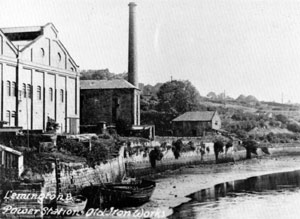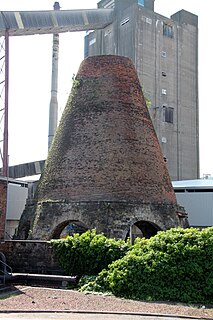
Blackfriars is a restored Grade I listed 13th-century friary in Newcastle upon Tyne, Tyne and Wear, England, located in the city centre, close to the city's Chinatown.

John Dobson was a 19th-century English architect in the neoclassical tradition. He became the most noted architect in the North of England. Churches and houses by him dot the North East – Nunnykirk Hall, Meldon Park, Mitford Hall, Lilburn Tower, St John the Baptist Church in Otterburn, Northumberland, and Beaufront Castle among them. During his career he designed more than 50 churches and 100 private houses. He is best known for designing Newcastle railway station and for his work with Richard Grainger developing the centre of Newcastle in a neoclassical style.

The history of Newcastle upon Tyne dates back almost 2,000 years, during which it has been controlled by the Romans, the Angles and the Norsemen amongst others. Originally known by its Roman name Pons Aelius, the name "Newcastle" has been used since the Norman conquest of England. Due to its prime location on the River Tyne, the town developed greatly during the Middle Ages and it was to play a major role in the Industrial Revolution, being granted city status in 1882. Today, the city is a major retail, commercial and cultural centre.

Joseph Cowen, Jr., was an English radical Liberal politician and journalist. He was a firm friend to Anglo-Jewry, and an early advocate of Jewish emancipation, regularly contributing to The Jewish Chronicle.

Newburn is a semi rural parish, former electoral ward and former urban district in western Newcastle upon Tyne, North East England. Situated on the North bank of the River Tyne, it is built rising up the valley from the river. It is situated approximately 5 miles (8 km) from the city centre, 14 miles (23 km) east of Hexham and 13 miles (21 km) south south west of Morpeth. In the 2001 census, the population was given as 9,301, increasing to 9,536 at the 2011 Census. Newburn is in the Newcastle upon Tyne district of Tyne and Wear and is part of the parliamentary constituency of Newcastle upon Tyne North.

Seaton Sluice is a village in Northumberland. It lies on the coast at the mouth of the Seaton Burn, midway between Whitley Bay and Blyth. It has a population of about 3,000 people.

Lemington is an area and electoral ward of Newcastle upon Tyne in North East England.

Dunston Power Station refers to a pair of adjacent coal-fired power stations in the North East of England, now demolished. They were built on the south bank of the River Tyne, in the western outskirts of Dunston in Gateshead. The two stations were built on a site which is now occupied by the MetroCentre. The first power station built on the site was known as Dunston A Power Station, and the second, which gradually replaced it between 1933 and 1950, was known as Dunston B Power Station. The A Station was, in its time, one of the largest in the country, and as well as burning coal had early open cycle gas turbine units. The B Station was the first of a new power station design, and stood as a landmark on the Tyne for over 50 years. From the A Station's opening in 1910 until the B Station's demolition in 1986, they collectively operated from the early days of electricity generation in the United Kingdom, through the industry's nationalisation, and until a decade before its privatisation.

Lemington Power Station was a small, now demolished coal-fired power station, located in North East England. It was situated on the Lemington Gut, a backwater of the River Tyne, at Lemington, 3.5 mi (5.6 km) west of Newcastle upon Tyne. The station's main building stood until 2017 as a rare example of an early power station, dating from before the nationalisation of the United Kingdom's electrical supply industry.

The Catcliffe Glass Cone is a glass cone in the village of Catcliffe in South Yorkshire, England. It is the oldest surviving structure of its type in Western Europe, and it is a Grade I listed building and Scheduled Ancient Monument. Only three other glass cones survive in the United Kingdom; at Lemington, Wordsley and Alloa.
Verreville Glassworks was established on the north bank of the River Clyde in the village of Finnieston in 1777. Glass making was discontinued in 1842. The buildings of the works, including the 120 feet high glasshouse cone, were converted into a pottery works which remained in production until 1918.
The Anglo Great Lakes Graphite Plant was a large graphite works situated in the North East of England. It was positioned at Lemington in Newcastle upon Tyne, on the north bank of the River Tyne. The plant was operated by the Anglo Great Lakes Corporation and produced high grade carbon for use in Magnox nuclear reactors, Advanced Gas-cooled Reactors and low grade carbon for use in carbon arc burning.

The Tyne Valley Line is a 58-mile (93 km) route, linking Newcastle upon Tyne with Hexham and Carlisle, England. The line follows the course of the River Tyne through Tyne and Wear and Northumberland. Five stations and two viaducts on the route are listed structures.

The Northern Glass Cone is a 19th-century glass cone formerly used in the glass manufacturing process at Alloa Glass Works in the burgh of Alloa, the administrative centre of the central Scottish council area of Clackmannanshire. The brick-built cone is the only such structure to survive in Scotland, and is one of four in the United Kingdom: the other three are at Lemington on Tyneside, Catcliffe in South Yorkshire and Wordsley in the West Midlands. It is a Scheduled Ancient Monument.
Newburn Steelworks was a large steel mill on the banks of the River Tyne at Newburn, near Newcastle upon Tyne, North East England.

The Darnall Works is a former steelworks in the Darnall area of Sheffield in England. The only remaining large complex of crucible furnaces, the works opened in the 1835 and were frequently extended and adapted until the late 20th century. Some of the structures at the works are listed buildings, at Grade II* and Grade II, and part of the site is a Scheduled Ancient Monument.

Nailsea Glassworks was a glass manufacturing factory in Nailsea in the English county of Somerset. The remaining structures have been designated as a scheduled monument.
Percy Main is a small village absorbed into North Shields, North East England. Historically in Northumberland, it is now part of Tyne and Wear.

The Guildhall is an important civic building in Newcastle upon Tyne. It is a Grade I listed building.
A glass cone is a glass production structure historically unique to the United Kingdom. A glass cone had a large central furnace, a circular platform where the glassblowers worked, and smaller furnaces around its wall to ensure the glass did not cool too quickly.
















